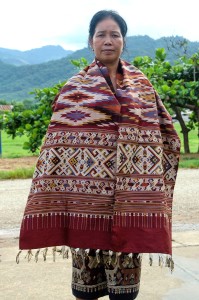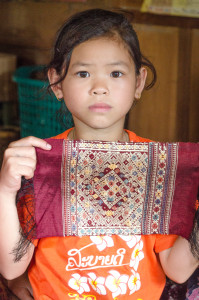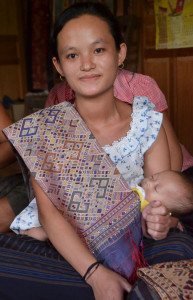The Traditional Silk Artists of Xam Tai, Laos
In the remote Annamite Mountains of NE Laos, and most notably in the Xam Tai District of Houaphon Province, the rich, cooperative, silk-weaving traditions of the Lao Loum and Tai Daeng ethnic groups still thrives, much in the way it has for millennia. Our family (mom, dad, and our now 22 and 19 year-old sons) has had the great privilege and opportunity to nurture friendships and forge textile-based business relationships with Xam Tai’s artists for the last 10 years. Their art, traditions and warmth have nourished us and opened up worlds of personal insight.
The silk weaving arts of the region are born from both Buddhist (the Lao Loum ethnic group) and animist (Tai Daeng and other Tai groups) traditions that are focused on healing and maintaining the strength of both the individuals and the community itself. The silk-raising and textile-creation processes have been central to beliefs and spiritual health and have also provided an economic foundation for countless generations. Not to diminish the essential building and farming roles of the men (all villagers participate with planting and harvesting), the women’s historical central role in textile creation has supported both core cultural beliefs and access to the cash-based trade-economy of the outside world. Because of this, women have been, on the whole, equally empowered and valued within the culture.
Local tradition holds that these complex weavings grant healers access to the spirits that affect health, both of the individual and of the community. Ancient motifs are woven into the textiles forming the geometric complexity; river-serpents (ngeuk) emblematic of female power, elephants (saang) that uphold political power, “hong” birds that represent male power, ancestor spirits, and fierce giant spirits (phii nak). These spirits can be invoked by shamans to heal a person from an injury or fever, protect an infant, revitalize an underperforming rice-field, or generate luck for a business venture.
Even today in the shade of the thatched-roof homes in Xam Tai, silk shaman, healing and other ritual and household textiles are still woven for economic support as well as actual village use. However, the textile’s role of accessing spiritual and ancestral power for healing is diminishing as their world increasingly overlaps the modern 21st century.
The traditional silk-weaving process in Xam Tai has six distinct roles:
- The seri-culturist, who raises the worms from tiny egg to fuzzy cocoon, all in the shade of their village home, taking great care to avoid disease and predators.
- The reeler, who nurtures the warmed silk strands through her fingertips, pull by pull, pacing her work to match the cooling rate of the silk’s sticky seracin.
- The dye-master, who pride herself on using only natural dyes created from what the jungle provides. A scale-bugs secretion, lac, forms the traditional foundation of red that is integral to so many of their textiles, but nearly every hue can be generated and fixed to silk.
- The pattern-template maker, who is likely also an expert weaver with highly-developed visual skills. The floor loom’s pattern-template (khao ti dai) contains the instructions for the weaver for the textile’s line-by-line creation as the weaver concentrates on her weaving precision and effective use of supplemental colors. A khao ti dai is saved for re-use, allowing certain effective, desirable patterns to be re-woven through the generations.
- The weaver (of whom there are several hundred in the Xam Tai region, age 7 to 80), who sit at their large floor looms and deftly and miraculously create the most intricate and vibrant traditional silks in the world. The region is most famous for its discontinuous supplemental weft patterns, but one also finds superb samples of tapestry weave, ikat and supplemental warp patterning. A singe large masterpiece shaman’s cloth (phaa phii mon) may take a woman 4 months to create at the loom. For many families, weaving is the sole source of income, keeping a high level of interest among women with the skill, patience and talent.
- The businessperson, who gets the silk to the marketplace (assuming that’s its destination). This vital role, which requires both economic savvy and outside contacts, is often managed by the dyer.

The design of the template-pattern can be clearly seen on this loom. After each horizontal memory-thread, which represents a line of pattern in the weft, is used, it is moved from the template’s top to the bottom; later, the memory threads will be moved from bottom to top, creating the traditional mirror-image motifs in the design-work.
While factory-spun silk, analine dyes and synthetic fibers are all readily available in local markets in Laos, the ethic of the silk-artist community of Xam Tai demands that the traditional processes be maintained. This cultural ethic has, for hundreds of generations, supported a cooperative and healthy lifestyle and economy that has allowed their traditional way of life to endure into the 21st Century. Their recent efforts to reach larger outside markets, as through our business, will be essential if these traditions are to continue to remain vital and attractive to future generations of Xam Tai’s cultural silk artists.









